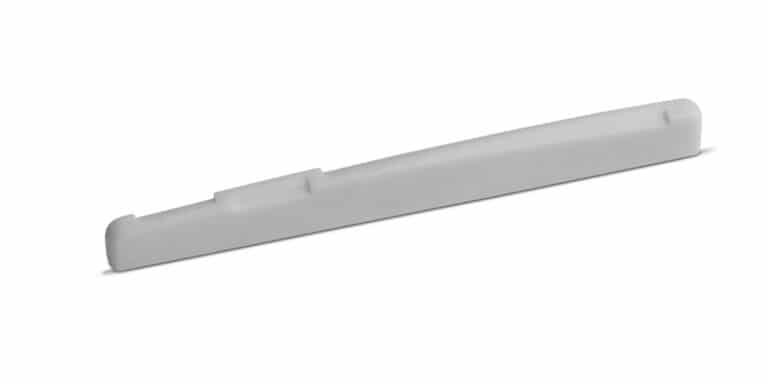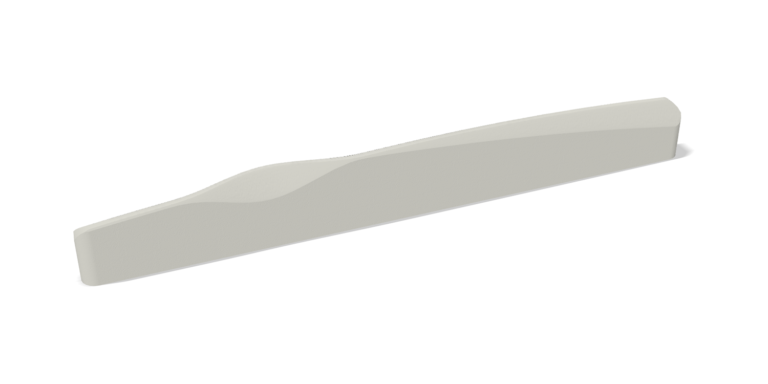Find the Right Saddle Size for Your Fender® Acoustic Guitar
Are you in need of an Fender steel string acoustic guitar saddle? Fender has made steel string acoustic guitars for well over half a century, and during this time has used numerous different saddle sizes and compensation patterns. This makes finding the correct saddle for your Fender difficult as there’s no single saddle size.
This article provides tips on finding the correct saddle for your Fender steel string acoustic guitar, but we suggest that you also measure your guitar’s saddle slot for a proper fit as every guitar is slightly different. If you are not the original owner, at some point someone may have installed a different saddle or have adjusted the saddle slot, producing different specs from the factory’s.
Step One: Determine Fretboard Radius
The fretboard radius on Fender acoustic guitar models varies significantly, anywhere from 7.25 inches on 1960s Kingman models, which were built with electric style necks, up to 16 inches on more recent models, and different radii in between.
To determine your fretboard radius, contact Fender customer support with your serial number. However, please note that if you are not the original owner, another neck may have been installed at some point. You may want to check the fretboard radius with a gauge. You can download printable radius gauges and check your fretboard. You can also view the below information, which lists some common Fender models and fretboard radii.
Common Fender Acoustic Guitar Fretboard Radii
- Models with 300 mm (11.81 inches) Fretboard Radius: FA-15, FA-125, FA-235E, FA-345CE, Tim Armstrong Hellcat.
- Models with 305 mm (12 inches) Fretboard Radius: Acoustasonic, CC-60, CC-140, CD-60.
- Models with 400 mm (15.75 inches) Fretboard Radius: PD-220E, Malibu, Newporter (Six String Models), PO-220E, PS-220E, Redondo, Sonoran Mini.
Step Two: Determine Saddle Length and Thickness
Fender acoustic saddles are often around 71 to 78 mm long, but this varies and can be much longer, particularly on some models from the 1970s. Also measure your saddle thickness, which also varies, but will typically be somewhere between 2.5 and 3.2 mm.
We also advise that you measure your saddle slot as you may need a slightly longer or thicker saddle from what’s currently installed for a snug fit. Your current saddle may not be the original. Additionally, wood will shift with humidity and this can result in subtle differences to your bridge’s saddle slot. See our article on How Tight Should an Acoustic Guitar Saddle Be? for more information.
Step Three: Determine Saddle Compensation Pattern
Compensation patterns also vary significantly on Fender steel-string acoustics. Below are some of the common patterns we’ve seen on Fender models.
Intonation Adjustable Bridge and Saddles
Similar to the bridge/saddles found on electric guitars, these bridges had a different saddle for each string with adjustable screw. This type of saddle is found on some 1960s and 1970s models. Different types of intonation adjustable bridges appeared on Fender models as well. Finding a replacement will prove extremely difficult as there’s no modern equivalent. Try checking reverb.com or ebay.com to find a replacement.
Non-Compensated Saddle
If your Fender acoustic was made before 2000, it likely originally had a non-compensated saddle. Height, length, radius will vary. Additionally, although non-compensated saddles all appear to be the same, variations exist. Please see our Guide to Non-Compensated Saddles for more information.
B Compensated with Slanted Bass

Fender acoustics built after 2000 often have a B compensated with slanted bass saddle. Although these look similar to many B compensated saddles found on Taylor or Gibson models, they will have additional compensation for the bass strings. Please see our article on acoustic saddle compensation patterns for more information. Height, length, radius will vary so please measure your current saddle and slot before ordering.
Slanted Bass Wave Compensated

From the factory, the Fender Acoustasonic models use GraphTech’s PS-9274-CO String Saver Saddle. Although at first glance, the Acoustasonic saddles look somewhat like Gibson forward line B compensated saddles, there are key differences. First, the Gibson saddles are forward line B compensated, whereas the Acoustasonic saddles are slanted wave compensated – please see our Guide to B Compensated Saddles and Guide to Wave Compensated Saddles for more information. Second, the Acoustasonic saddles are about 1.25 mm longer than the Gibson saddles are. See our Bone Saddle – Fits Some Fender Acoustasonic for a bone option, which will also fit some Fender Highway Series models.
Which Saddle Does Your Fender Need?
Still not sure what saddle size your Fender acoustic guitar needs? Please contact us with all of the following.
• Guitar Year, Model, Fretboard Radius
• Current Saddle Length, Height, Thickness
• Guitar Saddle Slot Length, Thickness (if different from saddle specs)
• Bass/Treble Edge Height Difference
• Current Saddle Compensation Pattern (please send a picture if you are not sure what type you have)
• String spacing at the bridge
We will respond within 48 hours.
